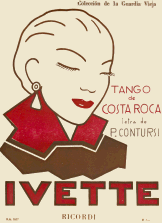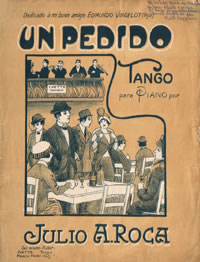By
Ivette - “Ivette”, an enigmatic tango

ue to the lack of evident documentation we should suppose that this tango was composed, or was made known, in 1918. The first recording is an instrumental played by the orchestra led by Celestino Ferrer and it dates back to August 16 in that year, Victor disc 72.161-A.
 The sheetmusic we own is lacking of date and printer's mark, it consists of only the music without lyric; the front cover is embellished and says: «Ivette. Tango for piano by Costa-Roca»; there are no dedications. On the other hand, in the sheetmusic with Pascual Contursi's lyrics published on February 28, 1919 the complete data plus the dedication are included: «To Mlle. Ivette. Published by Breyer Hermanos, Florida 414. Printed in March 1919»; on the inner page is the same text, and the personal seals of the authors that are used for commercial control. On the left the P. Contursi's seal is seen and to the right, on the writing «Music by Costa Roca», is the Augusto P. Berto's seal.
The sheetmusic we own is lacking of date and printer's mark, it consists of only the music without lyric; the front cover is embellished and says: «Ivette. Tango for piano by Costa-Roca»; there are no dedications. On the other hand, in the sheetmusic with Pascual Contursi's lyrics published on February 28, 1919 the complete data plus the dedication are included: «To Mlle. Ivette. Published by Breyer Hermanos, Florida 414. Printed in March 1919»; on the inner page is the same text, and the personal seals of the authors that are used for commercial control. On the left the P. Contursi's seal is seen and to the right, on the writing «Music by Costa Roca», is the Augusto P. Berto's seal.
To conclude with this issue, I want to highlight that other two publications of this piece, one in 1954 and another in 1998, published by Ricordi Americana SAEC, keep the same precepts that the previous ones.
We know that in the records of the Breyer Hermanos company a document was filed, dated in 1918, in which it is certified that Mr. Julio A. Roca, proxy of the Costa-Roca team sells the rights of the tango “Ivette” to Mr. Augusto Berto, for the amount of fifty pesos. Another document issued years later by the Sociedad de Autores y Compositores (Society of Authors and Composers) endorses the transaction on condition that the names Costa-Roca are kept as authors of the piece, explaining that they should be hyphenated. This explains the reason of the A. P. Berto's seal in the sheetmusic of 1919.
Who are Costa and Roca, composers of the music? We refer to the opinions of different historians that we have found in our archives and we bring them to our readers hoping to clarify this enigma.
José Gobello, in his book Tango, un siglo de historia (Tango, a century of history), published by Editorial Perfil, 1979. Page 594: «With his guitar Pascual Contursi went to Montevideo around 1914, and he stayed there until 1917, singing the lyrics that he wrote. From that period the lines of “Ivette” may come. The latter was a tango for piano signed by Costa and Roca, but surely written by José Martínez who by that time was pianist of the Francisco Canaro's quintet which boasted to be an orchestra».
Orlando del Greco, in Carlos Gardel y los autores de sus canciones (Carlos Gardel and the authors of his songs) Akian Ediciones, 1990, comments at the end of the portrayal by the director: «August P. Berto claimed “Ivette” as his own, one of the first tangos that Gardel recorded, and that those were the last names of two gentlemen to whom he dedicated the tango».
Gaspar Astarita, in his book Pascual Contursi. Vida y obra (Pascual Contursi. Life and Oeuvre), Edición La Campana, Buenos Aires 1981, writes an interesting biography that dedicated to his countryman Pascual Contursi. There he displays the lyric of the tango “Ivette”, pointing out that the music belongs to Enrique Costa and Julio Roca and the lyric, to Pascual Contursi. Later he adds a commentary by Adolfo Sierra: «In the tearoom located on Medrano and Rivadavia he used to meet with turf people, musicians and friends. There he composed the tango “Ivette” with José Martínez that Costa and Roca signed. The latter were the owners of the local to whom the authors paid old gambling debts and drinks with that gift». Despite Sierra's statement, the truth is that the mentioned tearoom was owned by Felman and Rodríguez Acal, founders of the local in 1884 and that they later reformed in 1920. According to the newspaper La Nación, of September 21, 1984, in its column entitled A hundred years back.
Miguel Ángel Morena in his Historia artística de Carlos Gardel, Ediciones Corregidor, 1985, announces that the tango “Ivette” was recorded by Carlos Gardel in 1920. He cut two takes: matrices 226 and 226/1. Enrique Costa, Julio A. Roca and Pascual Contursi are mentioned as authors.
Fernando O. Assuncao, in the El tango y sus circunstancias 1880-1920, Librería El Ateneo, 1984, says about the Costa-Roca team, that Costa is Emiliano Costa who in 1915 formed a trio with Manuel Aróztegui and Osvaldo Fresedo. He does not say what instrument he played.
 On the other hand, in our files we have a piano score of the tango “Un pedido” composed by Julio A. Roca, and dedicated «To my good friend Edmundo Vincelot (Jr.)» on whose cover is written: the author also composed the tango “Ivette” and the waltz “Frack Fiori”. Furthermore a bandstand is seen where a quartet comprised by piano, flute, bandoneon and violin is playing the tango “Ivette”, according to a sign applied in the external part of the balustrade of this compartment.
On the other hand, in our files we have a piano score of the tango “Un pedido” composed by Julio A. Roca, and dedicated «To my good friend Edmundo Vincelot (Jr.)» on whose cover is written: the author also composed the tango “Ivette” and the waltz “Frack Fiori”. Furthermore a bandstand is seen where a quartet comprised by piano, flute, bandoneon and violin is playing the tango “Ivette”, according to a sign applied in the external part of the balustrade of this compartment.
As for this gentleman Julio A. Roca, we don't know if he was the son of the former president Julio Argentino Roca, someone with the same name or a sobriquet.
Our friend, the great bandoneon player Chula Clausi, affirms that the tango was composed by José Martinez who, as a gift, gave it to Julio A. Roca, the son of the former president, and later the latter sold it to Berto.
The son of the general Roca had the same name as his father and was the one that signed with England the Roca-Runciman Treaty. It is said that he was a dandy, a bohemian that he frequented the Buenos Aires night and was a good tango dancer. As if all this were not enough, he had a brother-in-law whose family name was Costa and other, closely linked to the tango fable, the baron Demarchi.
Despite the difficulties due to the elapsed time, our research discovered some aspects of the mystery and today we can say, although we don't know exactly who Julio A. Roca was, that this gentleman was involved in the creation of the piece, to such an extent that he had the ability to sell it. Also we found out that the gentlemen Costa-Roca were never owners of the venue located on Medrano and Rivadavia. As for the contribution of the inspired composer José Martínez, we don't discard Clausi's statement but we have no ways to demonstrate it.
Up to here we've arrived.
Recordings of “Ivette”:
Orchestra Celestino Ferrer, instrumental (1918)
Carlos Gardel, with guitar by José Ricardo (1920)
Orchestra Julio De Caro, Instrumental (09/06/1926)
Sofia Bozán, with orchestra
Trío Ciriaco Ortiz, Instrumental (06/04/1937)
Cuarteto Los Ases, Instrumental (21/03/1941)
Jorge Vidal, with guitars by Jaime Vila (30/12/1952)
Cuarteto Roberto Firpo, Instrumental (26/08/1953)
Orchestra Aníbal Troilo, Raúl Berón (1955)
Cuarteto Troilo-Grela, Instrumental (27/08/1962)
Julio Sosa with orchestra Leopoldo Federico (29/11/1962)
Mario Bustos, with orchestra Osvaldo Requena
Josefina, with orchestra
Beba Bidart, with orchestra
Orquesta Tipica Montevideo, dir:Miguel Villasboas, Instrumental
Adriana Varela, with guitar by Esteban Morgado (1994)
Luis Cardei, with bandoneon by Antonio Pisano (1995y 2000)
Hipólito Paz, with guitars by Alfredo Sadi (2002)